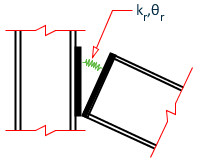Springs Connection
You are able to specify spring connection and assign it to a lateral beam. This type of connection is also referred to as moment connection which means that it only transfers moment between a beam and a column.
A connection spring can be assigned to either the left or right end of the beam. If values are not assigned to a particular end ("No Spring"), the Standard fixity assignments is used.
If the spring is infinitely stiff, connection rotation, θr , is zero. This means that two rigid plates are attached together and there is no relative rotation between them. This represents a fixed end condition for the beam and there is full moment transfer from beam to column or vice versa. On the other hand, θr is substantially large if kr is almost zero. This represents a pined end condition for the beam (no moment transfer between beam and column). These two extremes bound the range of the response of the connection. Any finite number of kr yields connection rotation within this range.
Connection stiffness (kr ) is defined in terms of moment per radian and this type of connection is only applicable for major axis bending. The term kr can be defined either as a percentage of beam major axis bending stiffness (i.e., 4EI/Imaj) or it can be directly entered by the engineer.

